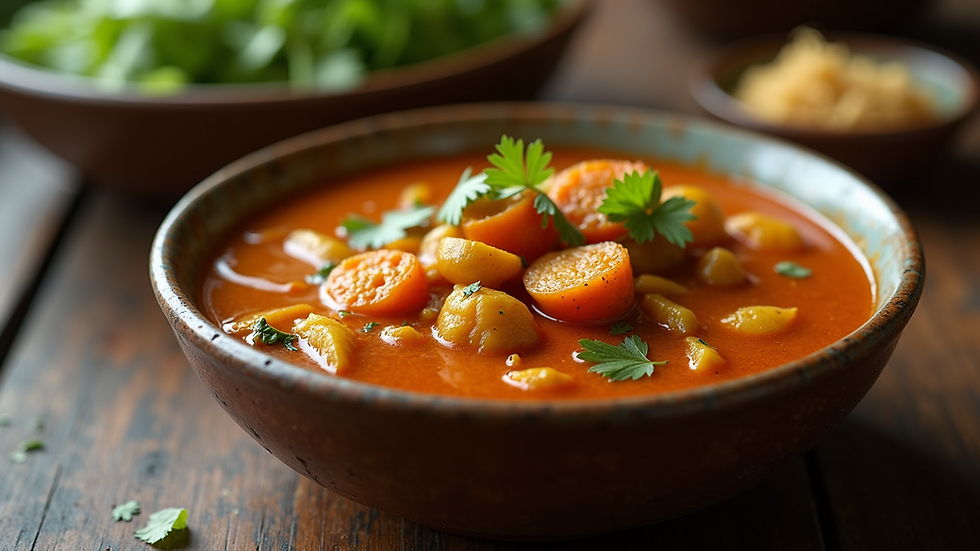The Timeless Tradition of Iyengar Sambar
- Chef Rini
- 26 minutes ago
- 3 min read
Sambar is a beloved South Indian dish, cherished for its rich flavors and wholesome ingredients. Among the many regional variations, Iyengar Sambar stands out for its unique preparation and taste. This traditional recipe has been passed down through generations, preserving the culinary heritage of the Iyengar community. The dish is not only a staple in many households but also a symbol of cultural identity and culinary artistry.
The Essence of Iyengar Sambar
Iyengar Sambar is distinct from other sambar varieties due to its specific choice of ingredients and cooking techniques. The Iyengar community, known for their meticulous approach to cooking, emphasizes balance in flavors and textures. The sambar is typically made with toor dal (pigeon peas), tamarind, and a special blend of spices that create a harmonious taste.
One of the key features of Iyengar Sambar is the use of fresh vegetables like drumsticks, carrots, and brinjal, which add natural sweetness and depth. The tempering or tadka is done with mustard seeds, curry leaves, and dried red chilies, enhancing the aroma and flavor. The dish is usually served hot with steamed rice, making it a comforting and nutritious meal.

How to Make Authentic Iyengar Sambar
Creating the perfect Iyengar Sambar requires attention to detail and the right ingredients. Here is a simplified overview of the process:
Soak and cook toor dal until soft and mushy.
Prepare tamarind extract by soaking tamarind in warm water and straining it.
Cook vegetables like drumsticks, carrots, and brinjal in the tamarind water.
Add cooked dal to the vegetables and tamarind mixture.
Season with Iyengar sambar powder, a special spice blend that includes coriander seeds, cumin, fenugreek, and dried red chilies.
Simmer the mixture to blend the flavors.
Tempering: Heat oil, add mustard seeds, curry leaves, and dried red chilies, then pour over the sambar.
For those interested in a detailed step-by-step guide, the iyengar sambar recipe available online offers an excellent resource.

The Cultural Significance of Iyengar Sambar
Iyengar Sambar is more than just a dish; it is a reflection of tradition and community values. In many Iyengar households, preparing sambar is a ritual that connects family members and honors their heritage. The recipe is often guarded and handed down from elders to younger generations, ensuring the preservation of authentic flavors.
This sambar is also a common feature during festivals and special occasions, symbolizing prosperity and togetherness. Sharing a meal that includes Iyengar Sambar is a way to celebrate identity and foster bonds within the community.
Tips for Perfecting Your Iyengar Sambar
To make your Iyengar Sambar truly authentic and delicious, consider these practical tips:
Use fresh tamarind for a tangy and vibrant flavor.
Cook dal thoroughly to achieve the right consistency.
Balance the spices carefully; the Iyengar sambar powder should not overpower the dish.
Add vegetables in stages to ensure even cooking.
Temper at the end to retain the aroma of mustard seeds and curry leaves.
Serve hot with freshly steamed rice for the best experience.
Experimenting with these tips can help you master the art of Iyengar Sambar and impress your family and friends.

Embracing the Tradition in Modern Kitchens
While the traditional methods of making Iyengar Sambar are cherished, modern kitchens can also embrace this timeless dish with ease. Using pressure cookers or instant pots can reduce cooking time without compromising flavor. Pre-made Iyengar sambar powder is available in stores, making the process more convenient for busy cooks.
Incorporating Iyengar Sambar into your weekly meal plan is a great way to enjoy a healthy, protein-rich dish that is both satisfying and flavorful. Whether you are a seasoned cook or a beginner, this recipe offers a wonderful opportunity to explore South Indian cuisine and its rich cultural roots.
Iyengar Sambar remains a culinary treasure that continues to delight taste buds and preserve tradition. By understanding its history, ingredients, and preparation, you can bring a piece of this heritage into your home and enjoy a meal that is both nourishing and steeped in culture.































Comments